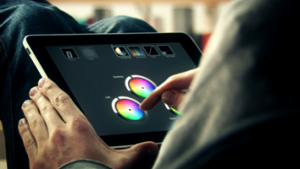Within hours of Steve’s sermon to the faithful, Stu Maschwitz had posted an article on his blog with a mock up of an iPad being used to control a colour grading application.
 Now some of you may not be aware of it but it turns out that a keyboard and a mouse are not the ideal devices for all interaction with a computer. Sometimes a tablet will work, but you still have the awkward dislocation between screen and tablet, and the need for two devices. Nope, for lots of applications you need lots of knobs, buttons, joysticks, toggles, sliders and faders. Particularly in the professional film and television production market there has been a long recognised need for specialist desks of controls and displays.
Now some of you may not be aware of it but it turns out that a keyboard and a mouse are not the ideal devices for all interaction with a computer. Sometimes a tablet will work, but you still have the awkward dislocation between screen and tablet, and the need for two devices. Nope, for lots of applications you need lots of knobs, buttons, joysticks, toggles, sliders and faders. Particularly in the professional film and television production market there has been a long recognised need for specialist desks of controls and displays.
So, here is the iPad, a relatively cheap, simple touch screen, with built in smarts and communications ports. It could be programmed to control a bunch of audio sliders, the next moment manipulating images, then on to reviewing and commenting on footage. Not only could you carry about your own personal, handy, UI to a large number of devices and applications, manufacturers could build them into those devices as universal control panels.
And that, for all those manufacturers of the amazing hardware control panels, is the world changing moment. If this happens, your multi-million dollar industry gets replaced by a few $10 iPad apps. Ooops.
Of course, and this is the rub, for this to happen the touch screen has to be fabulous. You need to be able to find your way around it just by touch, you need to be able to feel what you are doing, it needs to be responsive, elegant, intuitive and just plain lovely to use. Does the iPad deliver on that? I don’t know, but I suspect not, unless it has some very clever haptic (tactile) feedback stuff built in. Still, the writing is on the wall is it not?


[…] This post was mentioned on Twitter by Deep Sherchan, Chris Steele. Chris Steele said: New blog post: How the iPad could change the world http://effectivus.com/2010/04/how-the-ipad-could-change-the-world-2/ […]
Indeed the iPad will be succesful. There are many consumers out there that will find it easy to use and will pay money for the million small utilities and media that will be produced.
In the TV industry, I think it is a viable interface. Flexible, programmable, it could turn into any control surface. Old timers like me may feel that they need the thousand buttons on the dixital mixing desk, but for many more, they haven’t been brought up to require either mechanical or haptic feedback. They just want to have an analogue feel to the control surface. There isn’t room any more for all the video controllers, charater generators, DVEs; they can all be replaced by, as you say, a $10 software app and I can change that app when someone comes up with a new idea. The presenter can control the video wall with a screen that is readable and light weight.
I’m programming one right now. Just check the rumours on the networking side though.
IanM
Thanks Ian. I was a little skeptical, but in the face of a rumored 1 million sales, I’ve got to roll over and give up.
Consumer technology is invading not only the film & TV industry, but also defense (which always used to develop their own hardware). Quite what it means in the long term is another question. We’re used to getting 10 or more years of life out of our kit, I don’t think that will be the case with consumer kit. So, as we adopt it, we must also adopt the consumer manufacturing norms of service, reliability and product lifespan. Hmm.
Let us know about your ap!